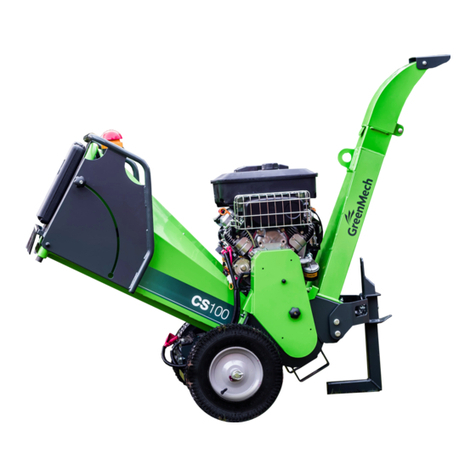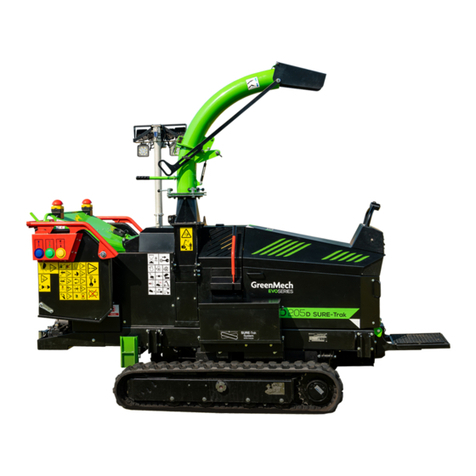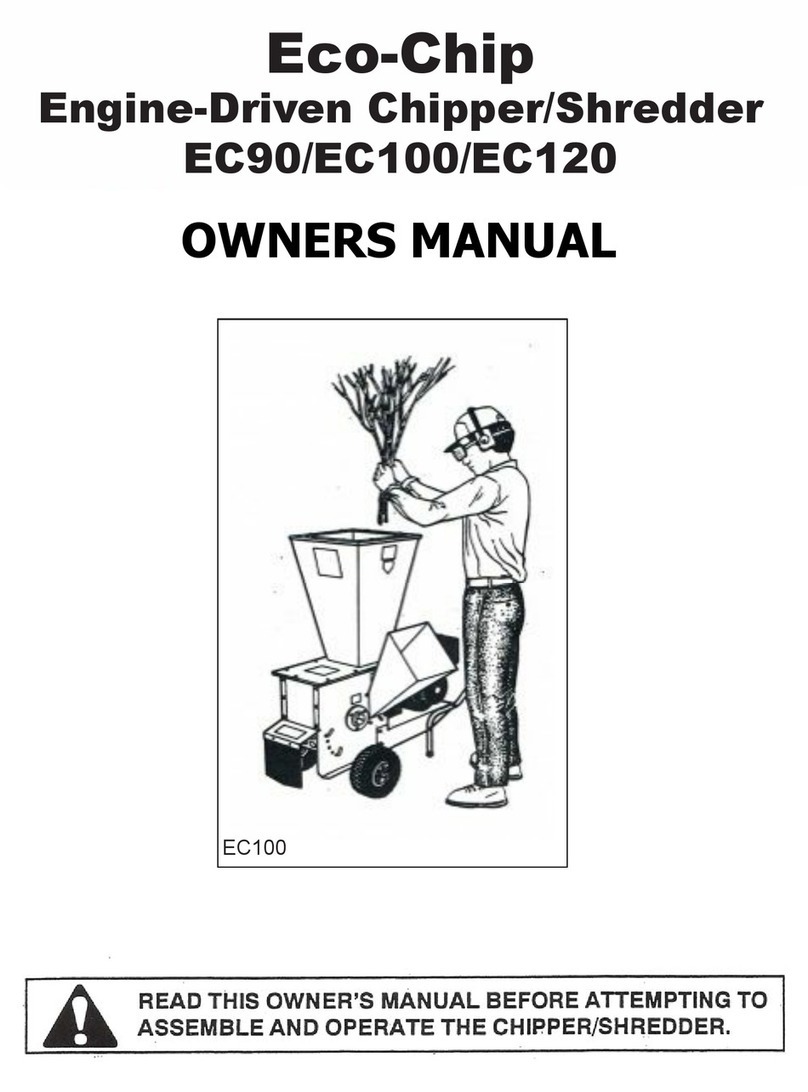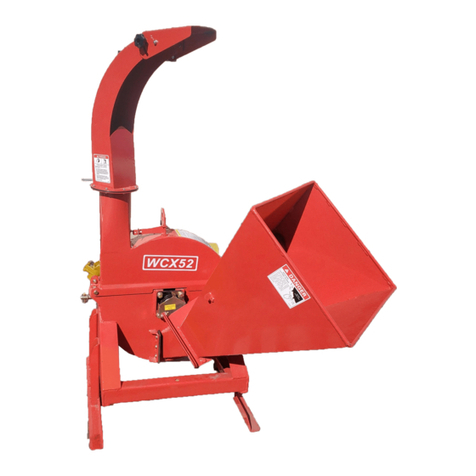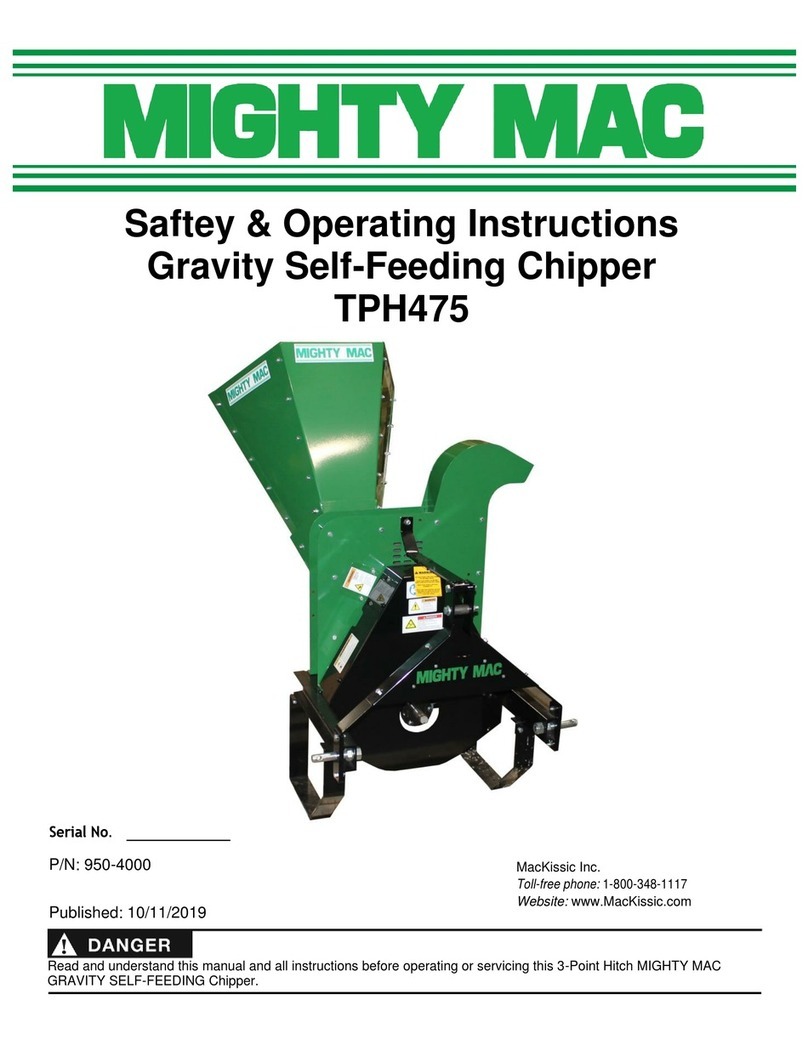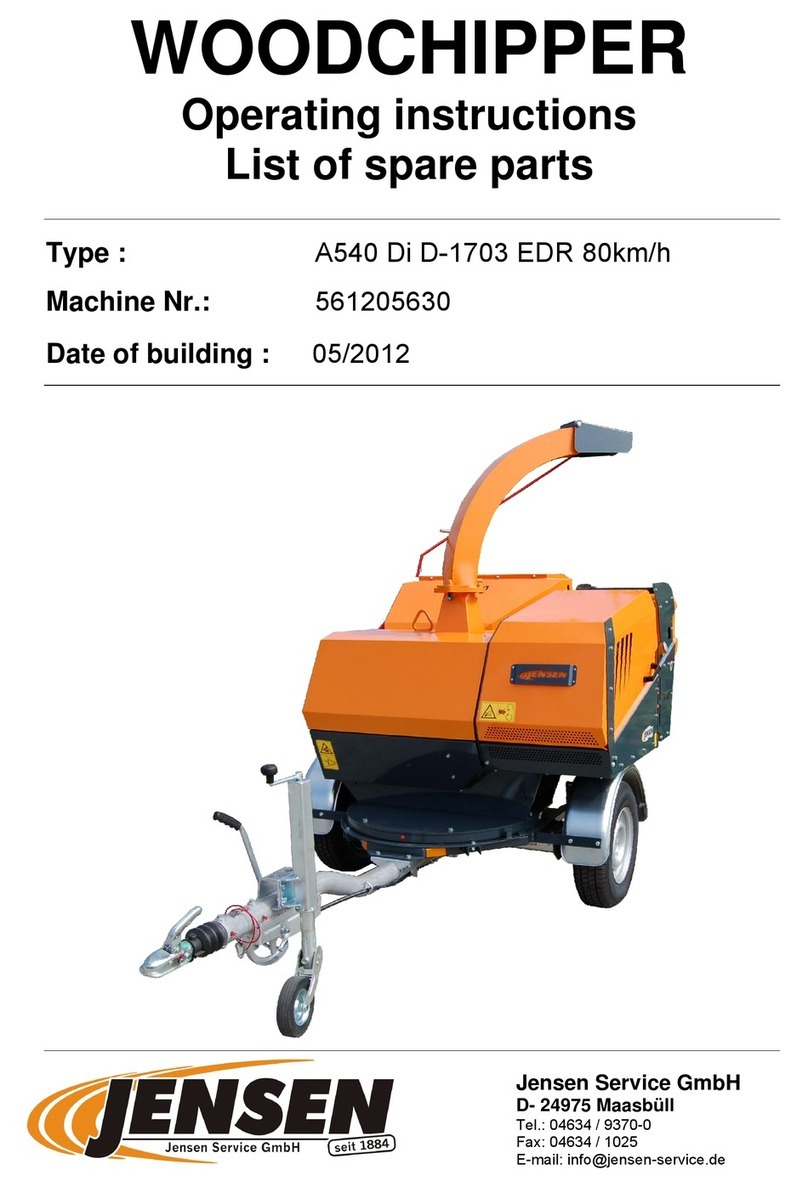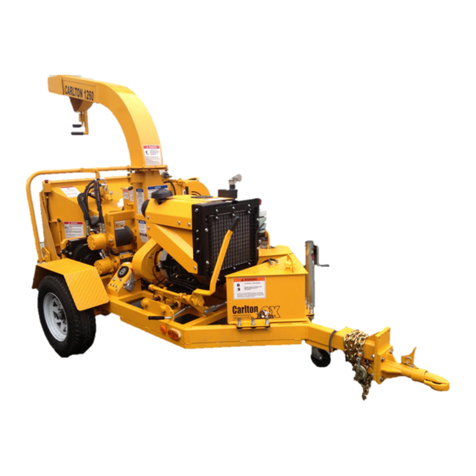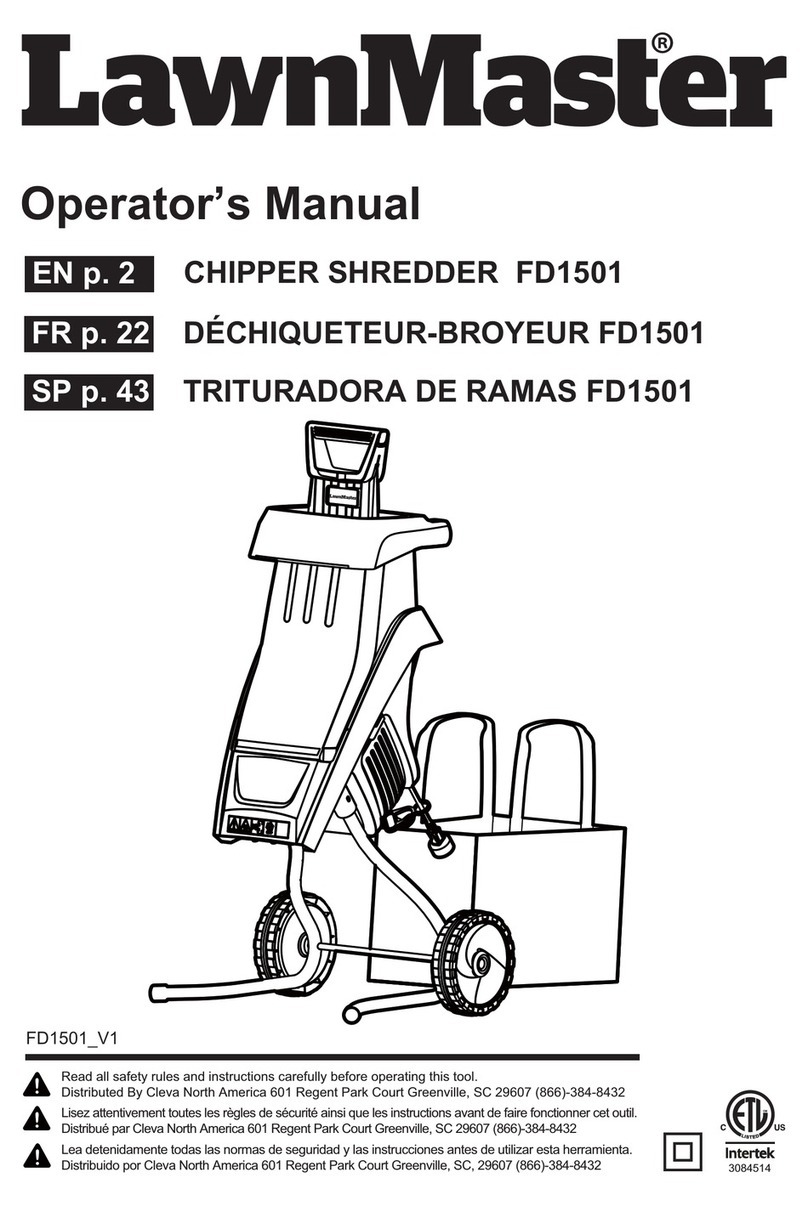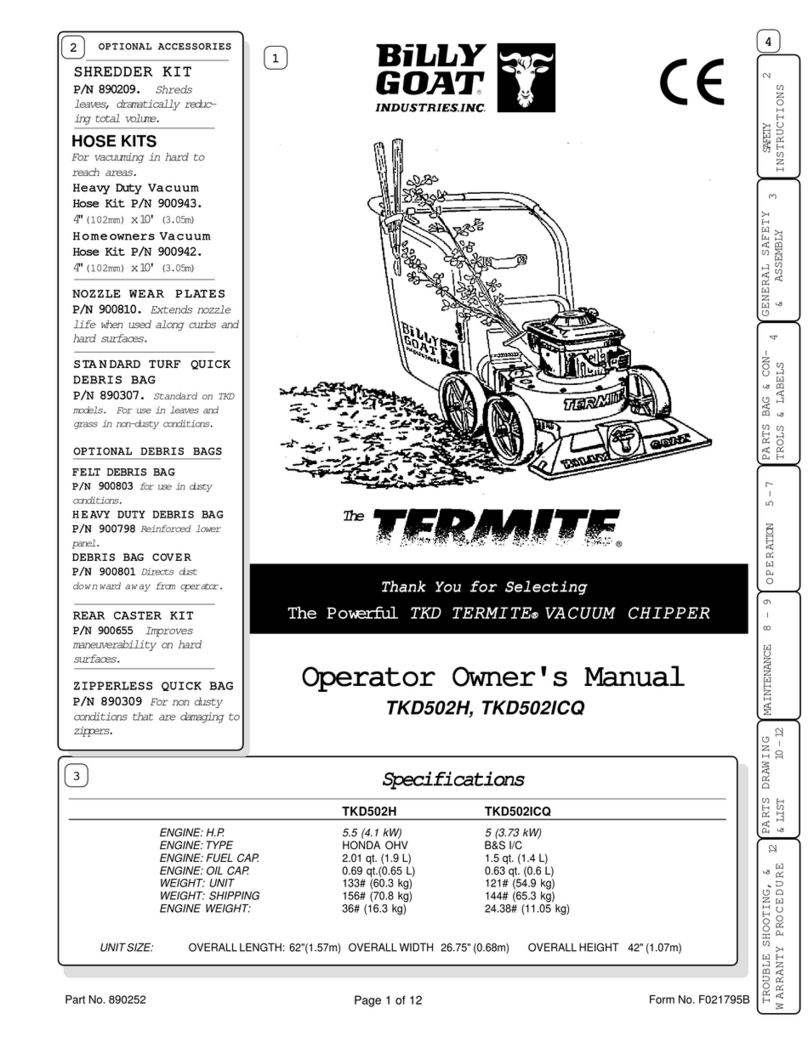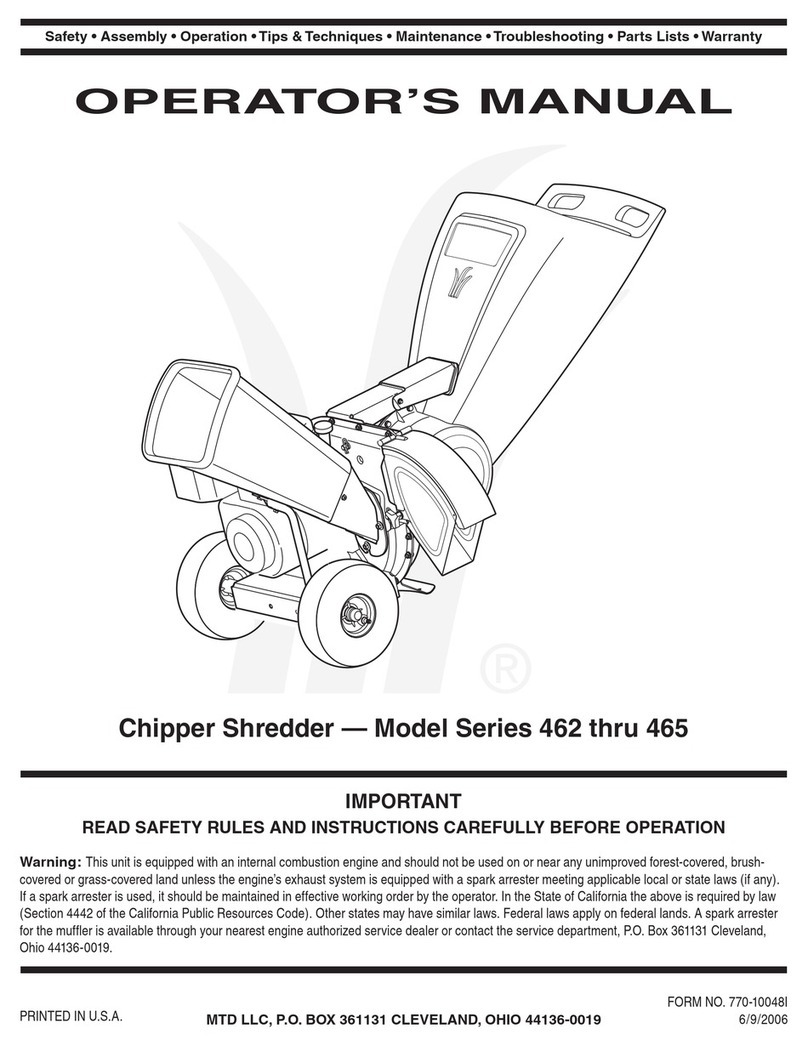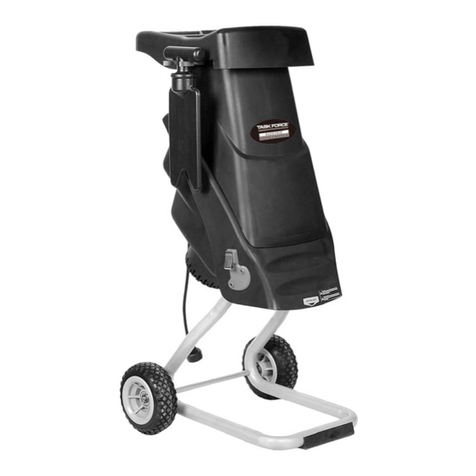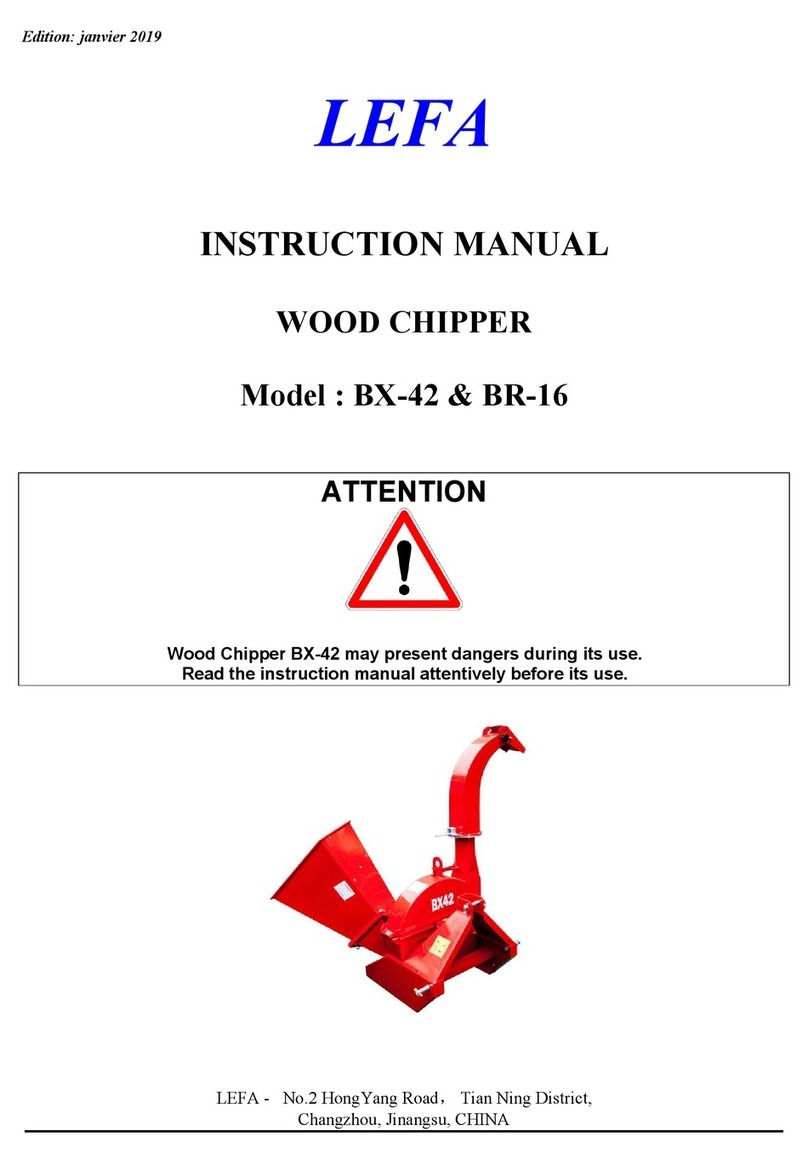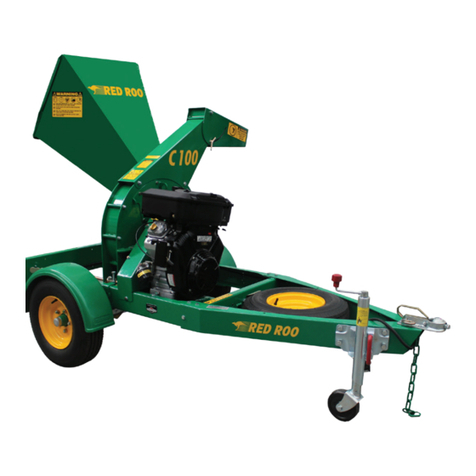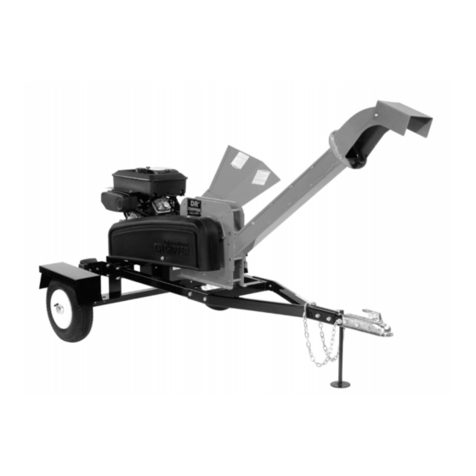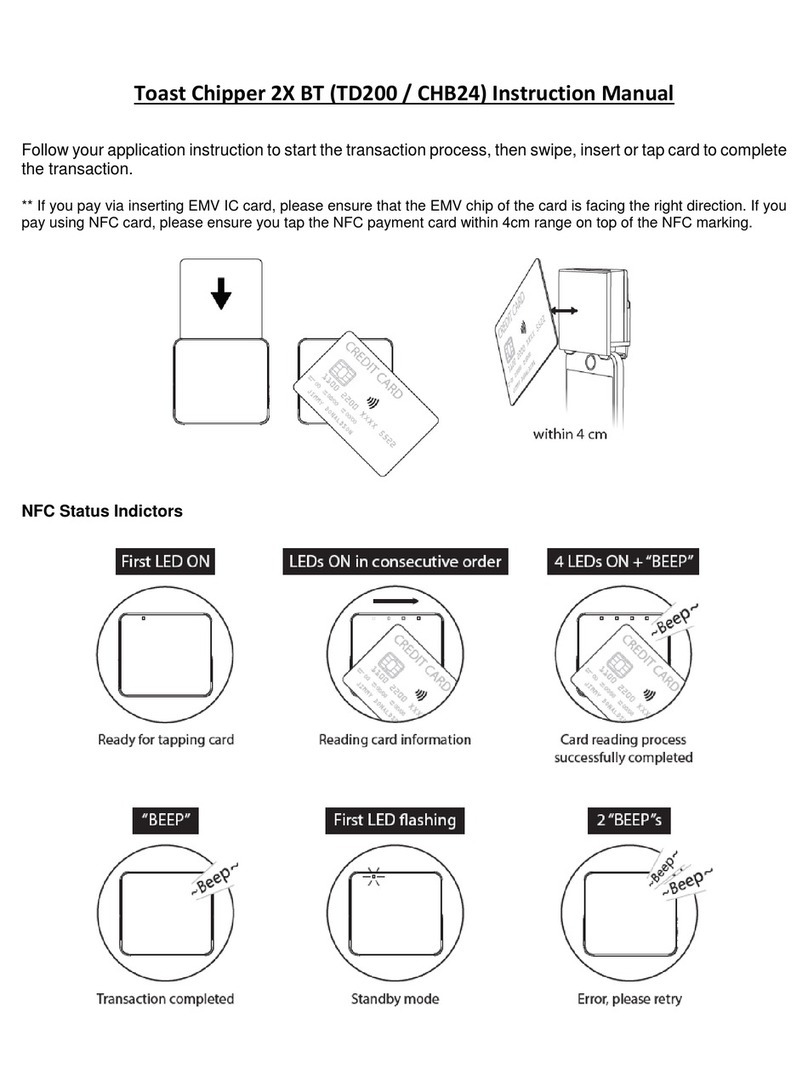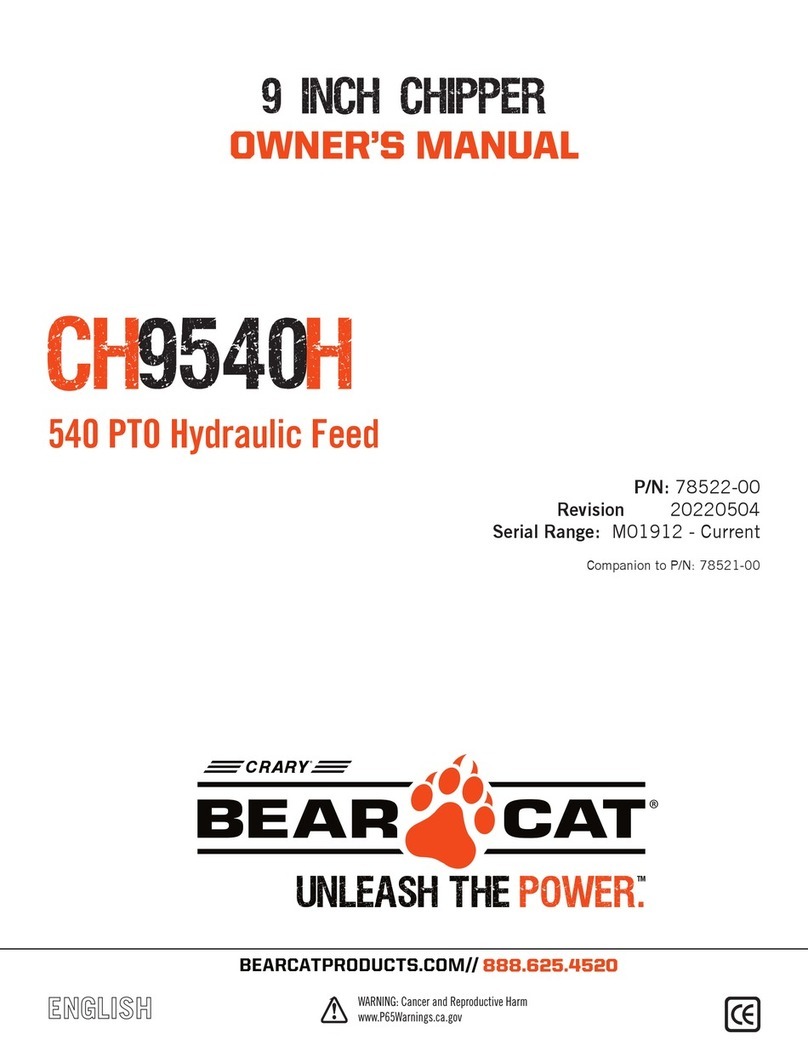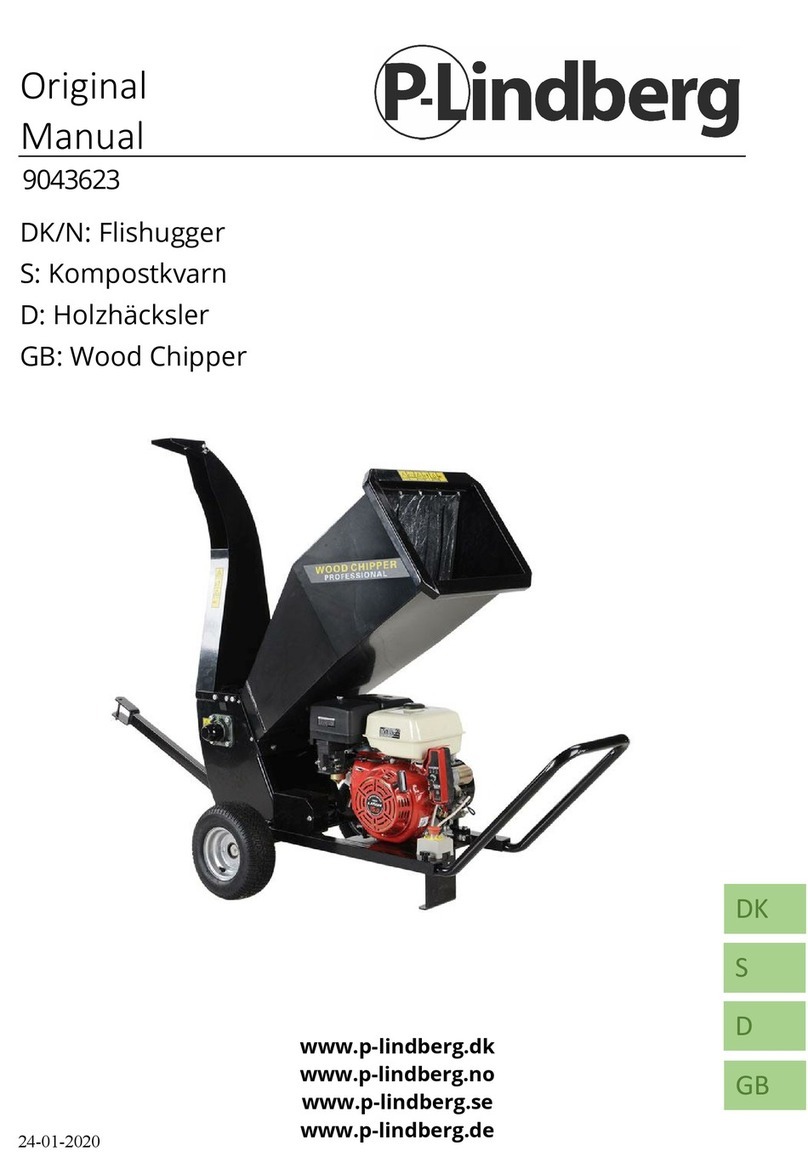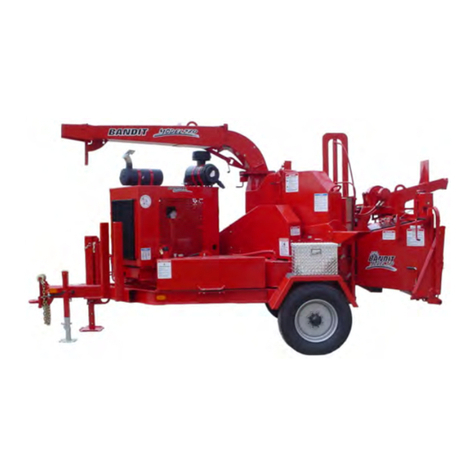GreenMech CS 100 User manual

CS 100
COMPACT 4-INCH
CHIPPER
Operator’s Manual

GM C/S100 CONTENTS 1
©GreenMechLtd - 1 - 05/10
SECTION:
1. Introduction and Purpose
2. Technical Specifications, Dimensions, Noise Level, and
Lifting points
3. Safety and Symbols
3.1 Ensure!
3.2 Never!
3.3 Always!
3.4 Safety controls and switches
3.5 Control cut-outs
3.6 Symbols
4. Machine Preparation
4.1 Fuelling and parking
4.2 Infeed chute
4.3 Discharge chute
4.4 Power take off shaft length
5. Operation
5.1 Pre-work checks
5.2 Starting machine
5.3 Stopping machine
5.4 Operating Hints
5.5 Preparing for Transport on completion of work
6. Maintenance
6.1 Routine Maintenance schedule and lubrication points
6.2 Engine Oil
6.3 Fuel level
6.4 Air cleaner
6.5 Drive belts
6.6 Infeed Chute Flaps
6.7 Cutting unit
6.8 Steam cleaning
6.9 Wheels and Tyres
6.10 Bearings and pivots
6.11 Mountings
6.12 Battery
6.13 gearbox
6.14 Fault finding

GM C/S100 CONTENTS 2
©GreenMechLtd - 2 - 05/10
7. Storage
7.1 Storage
7.2 Removal from storage
8. Disposal
9. Appendix
9.1 Certificate of Conformity
9.2 Risk Assessment
9.3 Noise Assessment
9.4 Parts List
9.5 Transcript of HSE leaflet 604

GM C/S100 1. INTRODUCTION AND PURPOSE 1-1
©GreenMechLtd 1-1 05/10
INTRODUCTION
This manual explains the proper operation of your machine. Read these instructions
thoroughly before operating and maintaining the machine. Failure to do so could result in
personal injury or equipment damage. Consult your GreenMech supplier if you do not
understand the instructions in this manual.
CAUTION! This symbol indicates important safety messages in this manual.
When you see this symbol, be alert to the possibility of injury to yourself or
others, and carefully read the message that follows.
We recommend that you keep this manual with the machine in the box provided. Note
here the serial number and quote it in any communications. This is important when
ordering spares. Remember to include all numbers and letters.
VIN Number…………………………………
Serial Number............................................
Write in the number!
This manual covers the following models.
GM C/S100 Compact Chipper/ Shredder with interchangeable cassettes
Optional 14HP or 18HP (electric start) Briggs and Stratton Vanguard engines
GM C/S100TM tractor mounted version with gearbox and power take off (pto) shaft
instead of engine.
Accept where otherwise stated alternative paragraphs and illustrations for engine driven
and tractor mount versions are marked (a) and (b) respectively.
The information in this manual is correct at the time of publication. However, in the course
of development, changes to the machine specification are inevitable. Should you find any
information to vary from the machine in your possession please contact your GreenMech
dealer for up to date information.
The manual may contain standard and optional features and is not to be used as a
machine specification.
PURPOSE
CAUTION! This machine is designed solely to chip wood and must not be
used for any other purpose. The machine should only be used by trained
operators who are familiar with the content of this instruction manual. It is
potentially hazardous to fit or use any parts other than genuine GreenMech
parts. The company disclaims all liability for the consequences of such use,
which in addition voids the machine warranty.
Fig 1.1 Serial Number
Serial
Number

GM C/S100 2. SPECIFICATIONS 2-1
©GreenMechLtd 2-1 05/10
TECHNICAL SPECIFICATION GM C/S100-14 / GM C/S100-18
Chipping Capacity 4 to 6 m
3
cuttings per hr depending on material
Guaranteed wood diameter 80mm (3”)
Permitted wood diameter 130mm (5”)
Chipping Blades 2 reversible and regrindable blades
Rotor cutting width 310mm
Power Unit Briggs and Stratton 4 stroke Vanguard V Twin 14hp
or 18hp with electric start
Fuel Petrol 95 octane (unleaded)
Fuel Consumption (continuous) 2 8 lt/hour
Length (Transport) 1725mm
Length (Work) 2183mm
Width 760mm
Height (Transport) 1245mm
Height (Work) 1468mm
Feed Height 840mm
Weight (Empty) 195Kg / 197Kg
Fig 2.1 GM C/S100 Main Features
Stand
Fuel tank
Discharge chute
Chipper cassette
Infeed chute
Sto
p
Button
Drive cover
Engine controls

GM C/S100 2. SPECIFICATIONS 2-2
©GreenMechLtd 2-2 05/10
TECHNICAL SPECIFICATION GM C/S100TM
Chipping Capacity 4 to 6 m
3
cuttings per hr depending on material
Guaranteed wood diameter 80mm (3”)
Permitted wood diameter 130mm (5”)
Chipping Blades 2 reversible and regrindable blades
Rotor cutting width 310mm
Power Unit 15 - 30 HP Tractor with 3 pt. linkage and pto drive
Drive Shaft 6 spline 1.3/8” P T O drive from tractor
Support Linkage 3 point linkage Cat. 1 or Cat 2
Length (Transport) 1725mm
Length (Work) 2183mm
Width 760mm
Height (Transport) 1245mm
Height (Work) 1468mm
Feed Height 840mm
Weight (Empty) 195Kg
Fig 2.2 GM C/S100TM (Tractor mount) Main Features
Stand
Discharge chute
Chipper cassette
Infeed chute
Clutch (Stop) Control
Drive belt cover
Three point A frame
Clutch Re-start latch

GM C/S100 2. SPECIFICATIONS 2-3
©GreenMechLtd 2-3 05/10
Noise
Noise levels vary depending on type of material being processed. Also duration of
operation is variable. Noise emission tests have been carried out and the guaranteed
sound power level is displayed on the CE plate as follows: Lwa 120dB(A)
Minimise noise by slowing to idle or stopping the engine whenever chipping is not in
progress.
CAUTION! Operators must wear appropriate ear protection. Bystanders must be
kept away from proximity of machine.
Lifting Points
Ensure infeed chute is folded in and secured for transport. Sling from tubular handles of
fixed section of infeed chute and lifting point on discharge chute.
Drawbar and hitch or three point linkage
(a) Ring type hitch (b) tractor three point linkage.
CAUTION! Ensure that the towing vehicle or tractor is correctly suited to the machine
weight and (a) drawbar (nose) loading. If necessary check with national vehicle
legislation.

GM C/S100 3. SAFETY 3-1
©GreenMechLtd 3-1 05/10
3.1 ENSURE:
3.1.1 All Operators must be fully trained in
the use of their machine.
(Certificated Operator training courses are
available on request.)
3.1.2 The Operators Manual is read and
understood.
3.1.3 The enclosed HSE guidance notes
are read and understood.
3.1.4 Appropriate Personal Protective
Equipment (PPE) is worn, including non-
snag clothing, gloves, eye and hearing
protection.
3.1.5 The machine is positioned on level
ground and the machine must be level with
the infeed chute at no less than 600mm
(23.62 inches) above ground level (fig
3.4.3).
3.1.6 All guards are fitted and in good
condition.
3.1.7 Blades are in good condition and
secure.
3.1.8 All blades are sharpened or replaced
in “Sets”.
3.1.9 All fasteners are checked regularly
for tightness.
3.1.10 Only “WOODEN” materials free of
nails etc., are fed into the machine.
3.1.11 Correct First Aid Kit including large
wound dressing is available on site.
3.1.12 Fire extinguisher is available on site.
3.2 NEVER:
3.2.1 Work on the machine until the
chipper disc is stationary and engine has
stopped.
3.2.2 Operate the machine without
protective clothing (Eye protection,
Earmuffs, and Gloves), or high visibility
clothing when working on roadside.
3.2.3 Operate with loose articles of
clothing, including loose cuffs on gloves.
3.2.4 Work under a raised component
without adequate safety support.
3.2.5 Operate the machine with untrained
personnel or with individuals present who
are not involved in the chipping operation.
3.2.6 Leave the machine unattended with
engine running at full operating speed.
(See section 4)
3.2.7 Put any part of your body into the
infeed chute while the machine is running.
3.2.8 Operate the machine whilst under the
influence of alcohol or drugs.
3.2.9 Operate inside a building or confined
space.
3.2.10 Climb on the infeed chute.
3.2.11 Impede or obstruct the Stop control.
3.2.12 Operate a p.t.o. driven machine
disconnected from and unsupported by its
power source
3.3 ALWAYS:
3.3.1 Check machine before starting (see
Section 4 Preparation and Section 5.1
Operation: Pre-work checks).
3.3.2 Be aware of potential hazards in the
work area, i.e. uneven ground, tree roots,
trip/slip hazards, obstructions and type of
materials being fed into the machine.
3.3.3 Feed from the side.
3.3.4 Keep clear of discharge area.
3.3.5 Have a second trained operator
within easy reach of the machine.
3.3.6 Maintain strict discipline at all times.
3.3.7 Service machine at specified periods.
(see Section 6: Routine Maintenance).
3.3.8 Note direction of discharge chute and
if necessary note the wind direction to
prevent debris from being blown into
highway or where it could affect members
of the public.
3.3.9 Remove key before doing any
maintenance.

GM C/S100 3. SAFETY 3-2
©GreenMechLtd 3-2 05/10
3.4 Safety Controls and Switches
3.4.1a Emergency Stop (fig 3.4.1a)
In the event of an emergency, push the
STOP button. This will lock in position to
stop the engine and machine.
3.4.1b Emergency Stop (fig 3.4.1b)
Identify the tractor p.t.o. and engine Stop
controls. In the event of an emergency,
stop the p.t.o. or tractor engine. This will
stop the machine. Pull the machine clutch
STOP lever. This will lock in position to
stop the rotor.
3.4.1.1 Once the emergency has been
rectified the following sequence should be
carried out:
3.4.1.2 Check over machine for any
blockages.
3.4.1.3 To reverse the cutter, remove the
drive guard and, using a bar through the
hole in the cutter spindle, manually turn the
cutter to free the obstruction.
3.4.1.4a When clear, pull the stop button
out and restart the engine.
3.4.1.4b When clear, release the reset
lever latch to re-engage.
3.4.2 Engine stop switch
3.4.2.1 To stop the engine, push the cut-off
switch to the ‘0’ position. (fig 3.4.2), or
(electric start) turn key switch anticlockwise.
CAUTION! Do not restart engine until
hazard has been removed.
3.5 Control cut-outs (engine drive only)
An engine cut-out is installed under the
drive guard to stop and prevent restarting.
due to specific events. The drive guard has
to be removed first to access the cutter or
dismantle the chutes
Fig 3.4.1a Stop Button
Stop Button
Fig 3.4.2 Engine Stop Switch
Stop switch
Fig 3.4.1b Stop and reset levers
Stop Lever
Reset Latch
Fig 3.4.3 Infeed chute height
Infeed chute
height 600mm
min. (24")

GM C/S100 3. SAFETY 3-3
©GreenMechLtd 3-3 05/10
3.6 SYMBOLS on the MACHINE
These relate to operator safety, correct use and maintenance of machine. Check that all
personnel understand and are familiar with meanings before using the machine.
Important Safety symbols
Take the correct action shown on the display below the stated hazard (see table)
Important Operating Checks Notice
Before use carry out daily the stated checks in the order shown (see table)
Caution! Do NOT start
engine
Caution!
Beware
flying
object
hazard
Beware
noise
hazard Caution!
Read
instruction
manual
Wear
helmet &
visor
Wear ear
protectors Keep nuts
tight
Machine
not level
-incorrect
Beware
flying
object
hazard
Beware
trapping
hazard
Beware
exposed
drives
hazard
Machine
level
-correct
Keep
bystanders
away
Wear
proper
clothes
Fit all
guards
Every 8 Hours –
Daily checks Stop Engine
1. Check
machine is level 2. Check engine
oil level 3. Check engine
air filter
4. Check infeed
chute is clear of
debris
5. Check cutter is
clear of debris
6. Check all
guards and flaps
are in place
7. Lock
discharge chute 8 Start Engine 9. Increase from
Idle to Run
General Safety
Daily Checks

GM C/S100 3. SAFETY 3-4
©GreenMechLtd 3-4 05/10
Important Safety Information
Maintenance Information
Sound level
Ear defenders must be
worn
Caution! Beware of thrown
object hazard
Action: Keepaway from fast
discharge chute
Caution! Beware of thrown
object hazard
Action: Stand to side of infeed
chute, NOT in centre.
Grease point
40 hours / weekly
Transport Lock
Lock this
component before
moving machine
Lift Point
Rotor Stop and Reset Levers

GM C/S100 4. MACHINE PREPARATION 4-1
©GreenMechLtd 4-1 05/10
4.1a Initial Fuelling and Parking
4.1.1a Position the machine on level
ground and ensure stand is secure (fig
4.1a).
4.1.2a Fill the fuel tank with petrol.
4.1.3a Check the engine oil level.
4.1.4a Check that the stop button is
released.
4.1b Fitting to tractor
4.1.1b Remove the top, and lower linkage
pins on the chipper (fig 4.1b)
4.1.2b Lower the three-point linkage on the
tractor and reverse up to the chipper.
4.1.3b Locate each tractor lower lift arm in
the corresponding clevis on the frame and
insert each lower linkage pin.
4.1.4b Secure the pins with the clips
provided.
4.1.5b Adjust the top link to the correct
length and locate the linkage pin through
the frame, secure with the clips provided.
4.1.6b Switch off the tractor engine.
4.1.7b Check that the PTO shaft is the
correct length for the tractor make and
model. See Section 4.4b below
CAUTION! The PTO shaft is equipped
with shear bolt protection and this end of
the shaft MUST be fitted to the tractor PTO
shaft. (Pictograms stamped on PTO shaft
cover may be incorrect.)
4.1.8b Depress the two spring buttons and
slide onto the tractor shaft until the buttons
spring out into the correct locations.
4.1.9b Depress the single spring button on
the ratchet clutch end and slide onto the
chipper gearbox shaft until the button
springs out into the correct location.
4.1.10b Ensure that the machine is secure
and stable on tractor linkage.
4.1.11b Ensure that p.t.o.shaft guard is
secure and restrained from rotation.
Fig 4.1a Stand and Infeed Chute
Stand
Hand nut
Fig 4.1b Tractor mountings and pto
Stand
P.T.O Shaft
Lower link pin

GM C/S100 4. MACHINE PREPARATION 4-2
©GreenMechLtd 4-2 05/10
4.2 Infeed Chute
4.2.1 Loosen hand nuts (fig 4.1a) and
swing the infeed chute extension into work
position.
4.2.2 Tighten hand nuts ensuring that
nylon spacers pass through holes at ends
of slot.
CAUTION! The infeed chute must not
be used at less than 600mm from the
ground. (fig 3.4.3).
CAUTION! Before transporting,
always fold up and secure the infeed chute.
4.3 Discharge Chute (Fig 4.3)
4.3.1 Release the spout clamp, remove
and reset the spout in the desired direction
and tighten the clamp.
4.3.2 Set the flap at the desired height.
CAUTION! Observe wind direction -
avoid danger of discharge blowing towards
operator.
4.4 PTO shaft length (Tractor mounted
only)
The PTO shaft must overlap by 150mm in
longest situation and not bottom out in
shortest situation. Always follow
instructions supplied with shaft if available.
4.4.1 To shorten PTO, separate each
section and refit to machine.
4.4.2 Raise machine on linkage until
shortest length is achieved.
4.4.3 Supporting the two sections side by
side, mark a point 25mm - 50mm back from
where the guard tube meets the joint guard
onto the other section. Repeat for the
opposite end.
4.4.4 Adjust the tractor linkage to set at
longest shaft length.
4.4.5 Check that 150mm minimum overlap
of sections is achieved between marks.
4.4.6 Saw off the surplus guard and shaft
at each mark and remove cuttings and
burrs.
4.4.7 Grease the shaft, reassemble to
machine, and test before use.
Fig 4.3 Discharge Chute
Alternative position (either side)
Spout clamp

GM C/S100 5. OPERATION 5-1
©GreenMechLtd 5-1 05/10
5.1 Pre-Work Checks:
5.1.1 Check machine is stable with support
stand lowered with pin in place (fig 5.1.1).
5.1.3a Check engine oil level (fig 5.1.2a - See
also 6.2 and Engine instruction manual).
5.1.4a Check engine air filter. (see Section 6.4)
5.1.5 Check fasteners for tightness.
5.1.6 Check cutter is free to turn.
5.1.6.1 If blocked, remove the drive guard and,
using a bar through the hole in the cutter
spindle, manually turn the cutter until free of
obstruction.
5.1.6.2 Check tightness of blade bolts and
condition of blades. See 6.7 for cutter blade
servicing.
5.1.6.3 Remove any loose material.
5.1.7 If any bolts are loose, refer to
maintenance section for further action.
5.1.8 Check discharge chute and flap is in
desired position and all clamps are tight. (see
Section 4.3)
5.1.9 Check infeed chute is folded out.
5.1.10 Check infeed rubber flaps are intact.
5.1.11 Check work area and erect signs and
cone off discharge area if necessary.
5.1.12 Check ALL safety procedures have
been followed.
5.2a Starting Machine:
5.2.1 Check all other personnel are clear of
machine.
5.2.2a Check that machine stop button is
pulled out to start.
5.2.3a Turn engine start switch to position I.
(fig 5.2a)
5.2.4a Open fuel tap by putting the vane to
vertical.
5.2.5a Set throttle to Slow and pull out choke.
5.2.6a Turn key or pull starter cord to start
engine.
5.2.7a Push choke back in.
5.2.8a Set throttle to Fast.
5.2b Starting Machine:
5.2.1 Check all other personnel are clear of
machine.
5.2.2b Start tractor and engage pto according
to tractor instructions.
5.2.3b If rotor not turning, using reset lever (Fig
5.2b), carefully unlatch clutch stop lever to start
drive.
5.2.4b Increase tractor speed to obtain 540
rev/min at pto shaft.
Fig 5.1.1 Support Stand
Support stand
and pin
Fig 5.1.2a Engine Oil and Fuel
Fuel Filler
Fuel tap Dipstick
Fig 5.2a Engine controls
Start -
Stop Throttle
Choke
Oil Filler

GM C/S100 5. OPERATION 5-2
©GreenMechLtd 5-2 05/10
5.3a Stopping Machine
5.3.1a Push the red STOP button.
5.3.2a Switch start key to position 0.
5.3.3a Wait for engine and cutter to stop.
5.3b Stopping Machine
5.3.1b Pull the clutch (Stop) lever (Fig
5.2b) towards infeed chute to disengage
belt drive and stop rotor.
5.3.2b Switch tractor start key to position 0.
5.3.3b Wait for engine and cutter to stop.
5.3.4b To re-start drive simultaneously pull
stop lever and unlatch with reset lever.
CAUTION! The cutter may take
several seconds to stop due to its inertia.
5.4 Operating Hints
5.4.1 Reduce the engine/ tractor throttle to
Slow whilst further material is collected for
chipping.
5.4.2 Take care when feeding wood into
the machine to allow for awkward shapes to
“KICK” when contacting the cutter.
CAUTION! Do not adjust discharge
chute when chipping is in progress.
CAUTION! A build up of debris risks
overheating of the engine and a risk of fire.
CAUTION! Keep working area around
the machine clear at all times and check
only authorised personnel are present.
5.5 Preparing For Transport On
Completion Of Work
5.5.1 Check that engine has stopped and
cutter is stationary.
5.5.2 Shake the machine and remove
surplus material from infeed chute and
machine surfaces.
5.5.3 Lift up infeed chute to transport
position and secure with hand nuts (fig 5.5)
ensuring spacers pass through holes at
ends of slots.
Fig 5.5 Infeed chute folded in
Hand nut
Fig 5.2b Machine Control
Reset Lever
Sto
p
lever

GM C/S100 6. MAINTENANCE 6-1
©GreenMechLtd 6-1 05/10
ROUTINE MAINTENANCE SCHEDULE
Where applicable (a) refers to Engine Driven (b) refers to Tractor Mounted
Note: Belt guard requires either spanner or hexagon key for removal.
CAUTION! Always press stop button, switch engine to 0 and check for rotation before
carrying out any maintenance.
Action Section Page
DAILY
Check engine oil level (ref: engine manual) 6.2 – 6.3 6-3
Check fuel level 6.2 6-3
Clean air cleaner (Engine driven only) 6.4 6-3
Check drive belt(s) 6.5 6-3
Check p.t.o. shaft and guard (ref: suppliers instructions)
Check condition of infeed chute rubber flaps 6.6 6-3
Check condition of cutter blades and retaining bolts 6.7 6-4
First 50 hours
Check drive belt tension 6.5 6-3
Check wheel and tyre condition and pressures 6.9 6-5
Check all mountings 6.11 6-5
Check battery levels (if fitted) 6.12 6-6
Service engine (engine driven only) Refer to engine manual
Change gearbox oil (tractor mounted only) 6.13 6-6
Weekly in addition to Daily actions
Check drive belt tension 6.5 6-3
Steam clean machine 6.8 6-5
Clean air cleaner 6.4 6-3
Check wheel and tyre condition and pressures 6.9 6-5
Grease all bearings and pivots 6.10, 6.1 6-5
Check all mountings 6.11 6-5
Check battery levels (if fitted) 6.12 6-6
250 hours in addition to Daily and Weekly actions
Check condition of bearings and pivots 6.10 6-5
Service engine (engine driven only) Refer to engine manual
Check axle mounting bolts for tightness 6.11 6-5
Check and grease wheel spindles 6.10 6-5
500 hours in addition to Daily and Weekly actions
Change gearbox oil (tractor mounted only) 6.13 6.6
ENGINE MAINTENANCE REFER TO ENGINE MANUAL
Tyre Pressure 1.4 bar (20 lb/in2)
Recommended lubricants Specification
Grease Complex grease EP2 (high temperature)
Engine SAE 15W-40 APICD
Gearbox (tractor mounted) SAE 90 Capacity .5 litres

GM C/S100 6. MAINTENANCE 6-2
©GreenMechLtd 6-2 05/10
6.1 Lubrication Points (see 6.14)
Grease except where stated
6.1.1 Cutter bearing (remove guard) 1 nipple
6.1.2 Cutter bearing (non-drive end) 1 nipple
6.1.3 Wheel spindles Remove wheel - smear with grease
6.1.4 p.t.o. shaft - both ends 2 nipples
6.1.5 Gearbox Check oil level and top-up as required
Note. Do not overgrease bearings as damage to seals may occur.
Fig 6.1a Lubrication points GM C/S100 Engine Driven
6.1.1 6.1.36.1.2
Fig 6.1b Lubrication points GM C/S100TM Tractor Mounted
6.1.1
6.1.4
6.1.2
6.1.5

GM C/S100 6. MAINTENANCE 6-3
©GreenMechLtd 6-3 05/10
6.2a Engine Oil
6.2.1 Check daily (fig 6.2). Refer to
engine manual to refill.
Engine Oil Filter
Refer to engine manual for replacement.
6.3a Fuel Level
6.3.1 Check daily before work and fill as
required (fig 6.2).
CAUTION! Use clean 4-stroke petrol
fuel only. If in doubt, use a funnel with a
filter.
6.4a Air Cleaner
Weekly
6.4.1 Remove cover (fig 6.4).
6.4.2 Unscrew nut to slide out element and
either blow out with air-line or gently tap on
smooth ground to release debris.
6.4.3 Replace element and cover.
6.4.4 Ensure hand nuts are secure.
6.5 Drive Belts (Fig 6.5)
Check daily, before work.
6.5.1 Remove guard and inspect.
Tension (not required on tractor mount)
Desired belt tension is 400N.
6.5.2 Check with tension meter (available
as an option.)
6.5.3 Release pulley bolt and adjust
locknuts on tensioning screw to set tension.
6.5.4 Tighten pulley bolt.
Replacement
6.5.5a Release pulley bolt and slacken
tensioning screw to allow belts to be
removed.
6.5.5b Pull stop lever to latch, loosen and
remove both pulleys to remove belts.
6.5.6 Fit new belts, ensuring they lie snugly
in the pulley grooves.
6.5.7 Tension belts, tighten pulley bolts
and replace guard securely.
Note: Re-tension new belts after 5
working hours (engine driven only).
Fig 6.5b Drive Belt
Clutch Latch
Pulley hub
Fig 6.5a Drive Belt
Pulley Bolt
Tensioner
Fig. 6.2 Engine Dipstick and Filler
Dipstick
Oil Filler
Fuel Filler
Fig. 6.4 Engine Air Cleaner
Air Cleaner
Cover

GM C/S100 6. MAINTENANCE 6-4
©GreenMechLtd 6-4 05/10
6.6 Infeed Chute Flaps (Fig 6.6)
Two slitted flaps protect the operator from
material thrown back up the infeed chute.
6.6.1 Replace flaps if damaged.
CAUTION! Do not operate with
missing or damaged flaps.
6.7 Cutter Blade Servicing
The cutter cassette is removed as a unit to
service the cutter blades.
Cassette removal (a) (fig 6.7.1)
6.7.1a Check engine is switched off.
6.7.2a Remove drive belts as 6.5 above
6.7.3a Fold the infeed chute in for transport
and secure.
6.7.4a Tip machine back onto infeed chute
and remove stand.
6.7.5a Tip machine forward to rest on feet
of cassette.
6.7.6a Remove 2 front bolts and 2 rear
bolts.
6.7.7a Carefully tilt machine back to
release cassette and rest machine on
infeed chute.
Cassette removal (b) (fig 6.7.1)
6.7.1b Disconnect pto shaft.
6.7.2b Remove drive belts as 6.5b above
6.7.3b Raise machine using tractor linkage.
6.7.4b Place stand under cassette.
6.7.5b Lower machine onto cassette stand.
6.7.6b Remove 2 front bolts and 2 rear
bolts.
6.7.7b Carefully raise machine to release
cassette.
Blade servicing (Fig 6.7.2)
CAUTION! Take care. Blades are
extremely sharp.
6.7.8 Slacken blades bolts with Torx tool
supplied and remove.
6.7.9 Turn blades round and refit to use
opposite edge.
6.7.10 Tighten blade bolts to 35Nm.
6.7.11 Check clearance to anvil is 0.5mm.
Note: If blades have been reground the
anvil will need readjusting to 0.5mm.
6.7.12 Reassemble cassette and refit to
machine by reversing procedure above.
6.7.13 Refit belts as 6.5 above.
6.7.14 Replace and secure drive guard.
Fig. 6.6 Infeed Chute Rubber Flaps
Rubber Flaps
Fig 6.7.1 Cassette Removal
Drive guard and
stand removed
Cassette
on feet
Fig 6.7.2 Blade removal
Bearing
Blade

GM C/S100 6. MAINTENANCE 6-5
©GreenMechLtd 6-5 05/10
Blade regrinding
Both edges of each blade must be ground
on front at 27˚angle and on back 10˚angle
over 4mm to ensure correct clearances.
When less than 48mm minimum width
blades may be raised by a suitable shim.
CAUTION! Blades must only be
sharpened by grinding on a bench grinder.
Do not sharpen with hand held equipment.
Always sharpen in sets to maintain balance
of cutter assembly.
6.8 Steam Cleaning
weekly and every 250 hours
6.8.1 Check all covers are fitted and closed
6.8.2 Steam clean machine surfaces.
6.8.3 Clean electrical components with a
damp rag, spray with WD40 and then wipe
with dry rag.
CAUTION! Do not steam clean
directly on to electrical components.
6.9 Tyres and Wheels
50 hours and 250 hours
6.9.1 Check condition of tyres.
6.9.2 Check pressures and inflate to 1.4bar
(20lb/in2) pressure as required.
6.9.3 Check wheel nuts are tight.
6.10 Bearings and Pivots
weekly
See paragraph 6.1 for routine lubrication.
250 hours
6.10.1 Check rotating components for
excessive movement and noise in
operation.
6.10.2 Replace as required.
6.11 Mountings
250 hours
6.11.1 Check that all mounting bolts are
tight.
Other manuals for CS 100
1
Table of contents
Other GreenMech Chipper manuals
